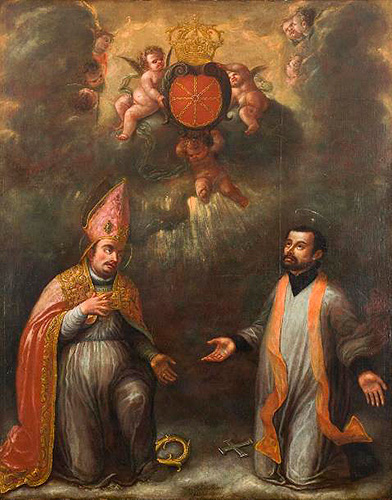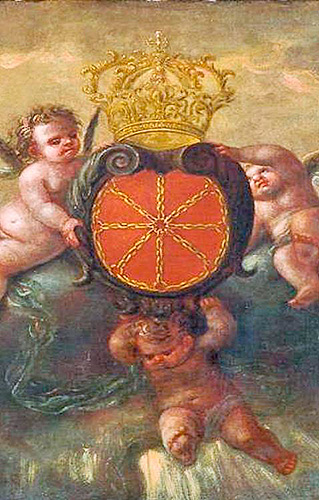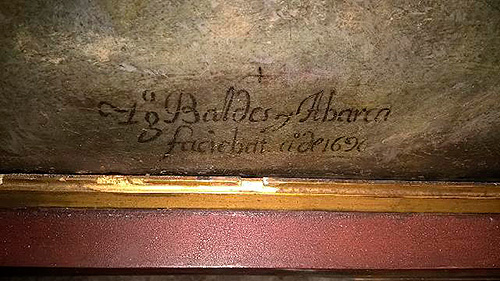The piece of the month of November 2019
"WE PRAISE OUR HOMELAND THROUGH YOU": AN IMAGE OF THE PATRON SAINTS OF NAVARRA PAINTED BY IGNACIO ABARCA Y VALDÉS (1696).
Alejandro Aranda Ruiz
Chairof Navarrese Heritage and Art
Since Pope Alexander VII approved in 1657 the concord of board of trustees of San Fermin and San Francisco Javier over Navarre, signed the previous year between the City Council of Pamplona and the Diputación del Reino, the representation of the two saints next to the arms of the old kingdom became more and more frequent. Without going any further, in that same year of 1657 Juan Andrés de Armendáriz painted for the Pamplona City Hall a commemorative painting of the event in which he represented San Fermín dressed in pontifical vestments imparting the blessing and San Francisco Javier with the livery of the Society of Jesus, the cross and the staff of lilies. Between the two saints were placed the coats of arms of Navarre and Pamplona as talking images of the two institutions that had proclaimed the two patrons. But without a doubt, the models that would most influence the representations of the patron saints with the coat of arms of Navarre would be the engravings, specifically those elaborated to illustrate the covers of the works of the chronicler of the kingdom José de Moret. Thus, in 1665 the Investigaciones históricas de las antigüedades del Reino de Navarra was published, preceded by the engraving drawn by Pedro Obrel and engraved by the Valladolid-born Cañizares, in which San Fermín and San Francisco Javier were depicted holding the arms of Navarre. They would be followed in 1684 by the cover of the first edition of the Annals of the Kingdom of Navarre with the engraving by Gregorio Fosman y Medina in which, as in the previous one, Fermín and Javier flank the coat of arms of the Kingdom of Navarre.
The idea of representing the saints next to the arms of the territory or city over which they exercised their patronage was not new. Prior to the concord of 1656, City and Kingdom had claimed the exclusive board of trustees of San Fermín or San Francisco Javier not only with texts, but also by means of images. Thus, each of the two saints was represented alone with the coat of arms of Navarre, translating by means of the image the forceful words that contained the passionate vindications of the Diputación and the Regiment. An example of San Fermin alone with the coat of arms of Navarre can be found in a canvas of the Consistory of Pamplona, dated in the second third of the XVII century, where the martyr bishop is represented next to the chains of Navarre and a parchment on which is written "DESCRIPTION OF THE KINGDOM OF NAVARRA CVIO patron saint IS SAN FERMÍN". On the other hand, San Francisco Javier has an engraving made in 1656 in Madrid by Matías Cristóbal and included in the lawsuit of the Kingdom against the City that is conserved in the General file of the Postulation of the Company. In it the saint is represented in full body, dressed with his characteristic attributes and leaning on a coat of arms of Navarre.

Saint Fermin and Saint Francis Xavier, patrons of Navarre.
Ignacio Abarca y Valdés, 1696.
It is in this context that this oil on canvas, measuring 1.93 meters high by 1.54 meters wide, depicting the two patrons of Navarre with the coat of arms of the kingdom, came to light. With the signature "Igº Baldes y Abarca faciebat aº 1696", the author can be none other than Ignacio Abarca y Valdés, born in León around 1675 and moved to Oviedo in 1708 where he died in 1738. Most of his scarce works revolve around religious themes, although he also painted canvases of mythological themes. His painting, described as sumptuous by the greatest connoisseur of this artist, Javier González Santos, sample a training Madrid or Valladolid with influences of Rubens and Luca Giordano. As had been customary since 1657, the painting depicts the two patrons of Navarre flanking the coat of arms of the kingdom. San Fermín, as established in the concord of board of trustees, occupies the preferential position on the right of the shield as pontiff and martyr, while St. Francis Xavier, priest and confessor, is placed on the left. Both saints are represented with their usual attributes. San Fermín appears dressed in pontifical with an alb girded by a cincture, pectoral cross, pluvial cape and red miter alluding to martyrdom. At his feet is the crosier. On the other hand, St. Francis Xavier wears the Jesuit cassock, surplice and red stole, a color similar to purple, destined by the liturgy prior to the Second Vatican Council for the rite of baptism, thus reinforcing the image of St. Francis Xavier as a missionary and evangelizer. In contrast to other representations, the only attribute that appears linked to the son of St. Ignatius is the cross, placed at his feet. Above the two saints, kneeling on a dark background, there is a break of glory in which, among clouds and beams of light, the coat of arms of Navarre appears, supported by three angels and surrounded by six cherub heads. All this allows us to deduce that in the composition of this work the painter was inspired by the numerous representations of the adoration of the name of Jesus by Jesuit saints, so common in the 17th century and to which Abarca would have access through engravings and prints. From them he would take the disposition of the two saints, kneeling and with their attributes on the ground, contemplating in an adoring attitude a break of glory in which instead of the anagram of the name of Jesus (IHS), the artist placed the coat of arms of Navarre.

Detail of the coat of arms of Navarre.
The question of when, how and where this painting was created is complex. Until a few months ago, the canvas was displayed on the fireplace of the Library Services of the Moxó Palace in Barcelona, residency program of the Marquises of San Mori. The date of the painting (1696) reveals that the work must have belonged to the period in which the author must have worked in the area of León, judging by the examples preserved in the cathedral of León, the Museum of León and the City Hall of La Bañeza. In this sense, the painting, in spite of its Navarrese theme, must have been created in a Leonese environment, ruling out the more than unlikely transfer of the artist to the kingdom of Navarre. Consequently, the link between the painter and the iconography of this work could not be other than a Navarrese promoter or a person linked in some way with the old kingdom and resident at that time in León or its surroundings. Perhaps we should not rule out a possible intervention by Abarca's own wife, Rosa Gómez Echevarría, a native of Navarre and apparently from Pamplona. It could be that she was the one who put her husband or future husband in contact with the Navarrese or person linked to Navarre who made the order.

Detail of the signature "Igº Baldes y Abarca faciebat aº de 1696".
In any case, for the time being and until more information surfaces data, we can point to the possibility that one of the daughters of Don Pedro Alvarez de la Vega y Bracamonte, V Count of Grajal and Viceroy of Navarra for a few weeks in 1698, was behind Abarca's work. There is evidence that three daughters of the Count professed enclosure: María Manuela in 1689, María de la presentation in 1699 and María Francisca Javiera de las Llagas in 1713. Precisely in the Augustinian Recollect Nuns of Leon a canvas is conserved in which the same iconography is represented as in that of Abarca and which has been put in relation by Morales Solchaga with the profession of Maria Francisca Javiera in 1713. In this case, the link between the nun and a painting with a clearly Navarrese iconography could derive from the position that her deceased father held in Navarre. In connection with the hypothesis proposal by Morales, it can be suggested that this painting by Abarca was a precedent carried out by one of the two sisters who professed earlier: Maria Manuela or Maria de la presentation. However, this hypothesis presents some difficulties. In the first place, the professions of Maria Manuela and Maria de la presentation in 1689 and 1699 do not fit precisely with the date of the painting (1696) which, in case it was promoted by one of these two nuns, had to be executed after or before the profession. Secondly, it is worth asking what could have been the relationship of the daughters of the Count of Grajal with Navarre before their father came to serve the position of viceroy at the end of 1698. Prior to that date, there is no record that his military degree program took Don Pedro Alvarez de la Vega to Navarre. Likewise, his stay as viceroy in Pamplona was very brief, for having made his entrance in the capital on December 12, 1698, the Count died on the 26th of the same month. Although there is evidence of the residency program of his wife in the Royal Palace of the Navarrese capital, there is no record of his daughters, who, with the exception of María Francisca Javiera, were already in their respective cloisters at that time. Likewise, even if the dates fit and they had resided in Pamplona with their parents, a few weeks do not seem sufficient to establish any link with the kingdom subject . It is possible that his ancestor, Juan de Vega, Lord of Grajal and first Count, was Viceroy of Navarre in 1542, still survived in the family report . In fact, another hypothesis that can be put forward is that the commission of the painting was carried out by another person of the family of the Count of Grajal, perhaps by Don Pedro himself, and it was inherited by the Marquises of San Mori, descendants of Don Pedro Álvarez de la Vega. Thus, it could be affirmed that the painting in its more than 300 years of history continues in some way linked to the family that could have owned it promote, since it has recently been acquired by the Marquis of Jaureguizar, owner of the palace armory of Ripa, married to a relative of the San Mori and therefore a descendant of the V Count of Grajal.
Be that as it may, the character of this painting goes beyond the merely devotional, as the painting could be considered an allegory of the prestige and glories of Navarre in the terms of religion and antiquity in which it was conceived in the seventeenth century. Hence the importance given to saints and images linked to local history to increase the prestige of a city or kingdom, as Del Río Barredo states. Patrons thus served, according to Lope de Vega, to glorify and praise the homeland. This explains why similar compositions were used to decorate the covers of Father Moret's works dedicated to the history of Navarre. Consequently, behind this painting there was not only a religious motivation, but also a desire to have a testimony or visual reminder of the kingdom of Navarre with whom, without a doubt, the commissioner had maintained a very special relationship.
BIBLIOGRAPHY
BARÓN THAIDIGSMANN, J., GARCÍA DE CASTRO VALDÉS, C., GONZÁLEZ SANTOS, J. et al., Museo de la Iglesia, Oviedo: Catalog de sus colecciones, Oviedo, board de Gobierno del Museo de la Iglesia, 2009, pp. 290-294.
EZQUERRA REVILLA, I. J., "Vega, Juan de", in Real Academia de la Historia, Diccionario Biográfico electrónico, (in network, www.rah.es).
FERNÁNDEZ GRACIA, R., San Francisco Javier patron saint of Navarre. Fiesta, religiosidad e iconografía, Pamplona, Gobierno de Navarra, 2006.
FERNÁNDEZ GRACIA, R., Reges Navarrae. Imagines et gesta, Pamplona, Government of Navarra, 2002.
GONZÁLEZ SANTOS, J., "Abarca y Valdés, Ignacio", appendix de la Gran Enciclopedia Asturiana (1981-1991), t. XVIII, Gijón, Silverio Cañada Ed., 1993, pp. 1-3.
GONZÁLEZ SANTOS, J., "Pintura del Barroco y la Ilustración", in BARÓN THAIDIGSMANN, J. (Dir.), El arte en Asturias a través de sus obras, Oviedo, La Nueva España, publishing house Prensa Asturiana, S.A., 1996-1997, pp. 773-788.
GRAU. L. and CALLEJO, E., "Orisgonta: una iconografía recóndita", Brigencio: Revista de programs of study de Benavente y sus tierras, n.º 11, 2001, pp. 29-40.
MOLINS MUGUETA, J. L., Pamplona-Iruña. Casa Consistorial, Pamplona, Pamplona City Council, 1988.
MORALES SOLCHAGA, E., "San Francisco Javier y san Fermín, patron saints of the Kingdom of Navarra", San Francisco Javier en las artes. El poder de la imagen, Pamplona, Fundación Caja Navarra, 2006, pp. 342-343.
RÍO BARREDO, M. J. del, Madrid, Urbs Regia. La capital ceremonial de la Monarquía Católica, Madrid, Marcial Pons Ediciones de Historia, 2000.
SÁNCHEZ MARTÍN, J. L., "Álvarez de Vega y Bracamonte, Pedro", in Real Academia de la Historia, Diccionario Biográfico electrónico, (in network, www.rah.es).
